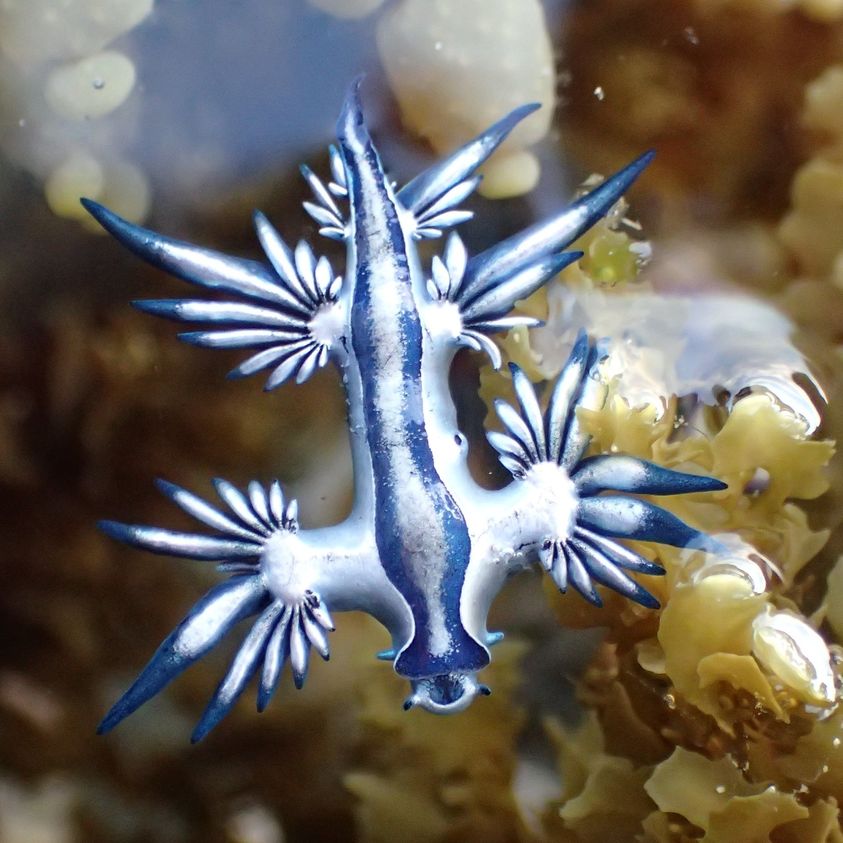
Distribution:
Tropical and temperate waters of the
Atlantic, Pacific, and Indian Oceans
Ecosystem:
Surface of the open ocean
Feeding Habits:
Carnivorous Predator
Taxonomy:
Family Glaucidae
Class Gastropoda
Overview and Physical Characteristics
When you first see a blue dragon sea slug (Glaucus atlanticus), you can immediately see the resemblance to the mythic creature that gives it its name. Conspicuously ornate with dark and light blue stripes, it has three pairs of tendril-tipped appendages that spread like wings, getting shorter as they go down its body, giving the nudibranch the appearance that is in flight.
But in reality, the blue dragon sea slug – also called the blue glaucus – is an ocean drifter, spending its life carried by ocean currents and the wind, buoyed on the water’s surface by a gas bubble located in its stomach. Glaucus atlanticus float on their backs, with their brightly patterned blue underbelly exposed to the sky, effectively camouflaged from predatory sea birds above, while their silvery gray downward-facing side blends perfectly with bright surface of the sea, effectively hiding them from the eyes of any hungry fish below.
Habitat and Distribution
The blue dragon is commonly found in temperate and tropical waters of the Atlantic, Pacific, and Indian Oceans. In recent years the range of Glaucus atlanticus has expanded down to the east and south coasts of Australia, to the waters off South Africa, and as recently as 2022 they were found washed ashore along the Texas Gulf Coast. This expansion of habitat is likely due to increased water temperatures from the impact of climate change and changes in ocean currents.
Behavior and Reproduction
The feathery tendrils sported by the blue dragon are more than just elaborate decoration – they hold a deadly secret. Glaucus atlanticus are foraging predators, and these tendrils, call cerata, hold highly poisonous stinging cells, used for both hunting and self-defense.
What is remarkable is that the blue dragon sea slug must borrow the poison essential to its survival. It only feeds on venomous creatures such as Portuguese Man O’ War, whose poisons do not affect them. As it consumes its prey with a set of sharp serrated teeth, Glaucus atlanticus appropriates the victim’s stinging cells and stores them in its cerata in a more highly concentrated dosage. At approximately 3 cm (1.2 in) in size, this increase potency of venom gives the blue dragon a vicious sting, allowing them to paralyze prey 300 times its size.
Blue dragon sea slugs are hermaphrodites, possessing both male and female reproductive organs, but their self-contained eggs and sperm are incompatible, so they must mate with another of their species to produce fertilized eggs. Seeking a mate for them is a haphazard business at best—they simply float along until they find another Glaucus atlanticus. But when they do find each other, they must be careful. Because of their numerous poisonous cells, extreme caution is needed to engage in mating. After successfully navigating sex, both individuals can lay a string of 20 eggs at a time, depositing their broods on pieces of driftwood, the carcasses of their victims, or any other floating mass they encounter. It takes about three days for the eggs to hatch into larvae.
Fun Fact
Blue dragons occasionally float together in a group, which is called a “blue fleet.” The group’s greater mass can sometimes cause them to be washed ashore by oceanic winds and tide. But beachcombers need to careful if they come across them, because an encounter with even a dead blue dragon sea slug can result in getting stung.
For More Information
- “Blue Glaucus” from Oceana
- “Definitely Don’t Touch the ‘Blue Sea Dragons’ Washing Up on Texas Beaches” by Emily McCullar from Texas Monthly
- “The Blue Dragon is a Master of Disguise” by Angela Heathcote from Australian Geographic
- “Blue Dragons: stunning creatures of the sea with a sting” by Channing Sargent from One Earth
This story is part of the “Unleashing the Science” series, showcasing how bureaus within the Department of the Interior produce and apply science to ensure responsible management decisions for our planet now and for the future.
--BOEM--
The Department of the Interior’s Bureau of Ocean Energy Management (BOEM) manages development of U.S. Outer Continental Shelf (OCS) energy, mineral, and geological resources in an environmentally and economically responsible way.

